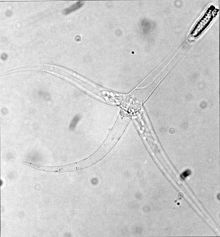黏体动物
黏体动物(学名:Myxozoa)是一类水中的寄生虫。其下已知有超过1300个物种,当中很多需要两个寄主,如鱼类及环节动物或外肛动物。粘孢子虫的孢子平均约有10-20微米大;[1]而软孢子虫(Malacosporea)的孢子则达2毫米大。有瓣的孢子会造成感染。这些孢子内含有1-2个孢子母细胞及1个或以上的极囊,极囊内有极丝可以将孢子固定在寄主之上。孢子母细胞接着会被释放成为伪足孢子,可以穿透寄主的组织,发展成1个或以上的多核原生质团。某些核会再次组合,其中一个会吞噬另一个,形成新的孢子。
| 黏体动物亚门 | |
|---|---|

| |
| Triactinomyxon stage of Myxobolus cerebralis. | |
| 科学分类 | |
| 界: | 动物界 Animalia |
| 门: | 刺胞动物门 Cnidaria |
| 亚门: | 黏体动物亚门 Myxozoa Grassé, 1970 |
| 亚纲 | |
种系发生
编辑黏体动物最初被认为是一类原生动物[2],并被分类在孢子虫纲中。[3]由于它们在18S核糖体DNA测序中有独特的特性,故它们被重置到后生动物。不过后来却发现了一些矛盾的证据而影响了其分类:虽然18S核糖体显示它们接近刺胞动物门[4],但其他的搜集到的核糖体DNA[5][6]及Hox基因[7]却指向与两侧对称动物相似。
后来发现长2毫米的Buddenbrockia plumatellae原来也是黏体动物[5],加强了两侧对称动物分类的说法,因为这种动物的身体构造表面上接近。无论如何,仔细的检测发现Buddenbrockia并非在纵面上两侧对称,而是四侧对称的,故对此说法仍存有怀疑。
进一步的研究搜集了Cristatella mucedo的前三个Hox基因及白斑狗鱼的第四Hox基因,并解释了黏体动物分类的矛盾。原来最初的实验是采用了寄主受污染的组织,导致了两侧对称动物的误测。后来小心复制了Buddenbrockia的50个编码基因,显示它们是非常进化的刺胞动物门成员,而水母亚门是其最近亲。黏体动物的极囊与刺胞动物门的刺细胞也有相似的地方,不过相信是趋同演化的成果。[8]
下属分类
编辑黏体动物纲包括以下目:
- 目的地位未定的科:
黏体动物其下有几个物种,包括:
参考
编辑- ^ Fiala, Ivan. Myxozoa. The Tree of Life Web Project. 2008-07-10 [2010-03-31]. (原始内容存档于2018-03-01).
- ^ Štolc, A. Actinomyxidies, nouveau groupe de Mesozoaires parent des Myxosporidies. Bull. Int. L'Acad. Sci. Bohème. 1899, 12: 1–12.
- ^ Edwin Lanfranco. A phylogenetic classification of organisms other than animals (PDF). Diversity of Non-animal Organisms. 2007: 1–39 [2010-03-31]. (原始内容存档 (PDF)于2008-12-16).
- ^ Smothers, J.F.; et al. Molecular evidence that the myxozoan protists are metazoans. Science. September 1994, 265 (5179): 1719–1721. PMID 8085160. doi:10.1126/science.8085160.
- ^ 5.0 5.1 A.S. Monteiro; et al. Orphan worm finds a home: Buddenbrockia is a Myxozoan. Mol. Biol. Evol. 2002-06-01, 19 (6): 968 [2010-03-31]. PMID 12032254. (原始内容存档于2008-05-11).
- ^ J. Zrzavy & V. Hypsa. Myxozoa, Polypodium, and the origin of the Bilateria: The phylogenetic position of "Endocnidozoa" in light of the rediscovery of Buddenbrockia. Cladistics. April 2003, 19 (2): 164. doi:10.1111/j.1096-0031.2003sampled+.tb00305.x (不活跃 2010-03-17).
- ^ C. L. Anderson, E. U. Canning & B. Okamura. A triploblast origin for Myxozoa?. Nature. March 1999, 392 (6674): 346–347. doi:10.1038/32801.
- ^ E. Jímenez-Guri; et al. Buddenbrockia is a cnidarian worm. Science. July 2007, 317 (116): 116–118. PMID 17615357. doi:10.1126/science.1142024.
- ^ Kent, M. L., Margolis, L. & Corliss, J.O. The demise of a class of protists: taxonomic and nomenclatural revisions proposed for the protist phylum Myxozoa Grasse, 1970. Canadian Journal of Zoology. 1994, 72 (5): 932–937.
- ^ Tetracapsuloides bryosalmonae. Parasite of the Day. [2024-03-28].